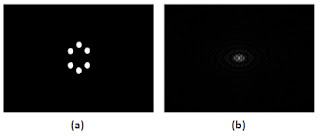PART A: CONVOLUTION THEOREM
First off, let us look at the following 2D patterns:
 |
| Figure 1. (a) Two dots lying on the x-axis and symmetric about the y-axis. (b) The modulus of the Fourier Transform of (a). |
We have already seen Figure 1 in a previous blog. Now, instead of dots let us use circles of varying radius. From Figure 2, we observe that the FT modulus of our 2D pattern is given by "distorted" concentric circles. Moreover, as the radius of the circles increase the size of this interference pattern decreases.
What if we replace the dots with squares instead of circles? In Figure 3, we see exactly that. In addition, given the respective fourier transform of each pair of squares we see that as the side length increases the width of the distorted cross or plus sign (interference pattern) decreases.
 |
| Figure 4. The first row is composed of images of gaussians of varying variance. The second row is the modulus of the Fourier Transform of a respective gaussian pair. |
Let us now try another 2D pattern - gaussians of varying variance. As seen in the Figure above (Figure 4), the interference pattern size decreases as the variance decreases. This trend is similar to the first two patterns.
Another interesting thing that we will look at now is the convolution of two images. In Figure 5b we see the the result of the convolution of a vertical line (3x3) with the set of random points shown in 5a. What we see in 5b is the replication of the vertical line in every location where there is a random point.
 |
| Figure 5. Convolution. (a) Random points. (b) Convolution of a vertical line (3X3) to the random points of (a). |
 |
| Figure 6. The first column is composed of images of equally Spaced dots lying on the x and y axis. The second row is composed of the modulus of the FT of the images in the first row. |
 |
| Figure 7. Fingerprint (source) |
Given an image of a fingerprint, we can enhance the identifying marks or ridges in that fingerprint by masking unwanted frequency in the fourier domain. We start with the following:
a. Take the Fourier transform of the image.
b. Design a filter for it.
c. Apply filter.
 |
| Figure 8. (a) FT modulus of Figure 7, (b) the filter I chose to mask unwanted frequencies, and (c) Resulting image. |
Note that the output is not quite right. I would have to say that the error came from the choice of mask used.
PART C. LUNAR LANDING SCANNED PICTURES: LINE REMOVAL
Applying masks can also be used in removing unwanted portions of an image. Here, we have an image where unwanted vertical marks is to be removed. I used the following mask in "filtering" the image.
Upon applying this, I was able to obtain the image in Figure 10b. I would have to say it looks pretty good.
 |
| Figure 10. (a) Image with unwanted vertical lines, (b) filtered image |
Here is a similar case to the previous section. However, in this case we need to remove the weave marks instead of vertical lines. Shown in Figure 11 is
 |
| Figure 11. Filter choice |
 |
| Figure 12. (a) Image with weave marks. (b) filtered image. |
Unfortunately, it looks like the marks weren't removed. Once again, I strongly believe the error is in the choice of the filter.
 |
| Figure 13. (a) Inverted Filter. (b) FT modulus of (a) |
Lastly, inverting the filter and taking it's FT modulus, we try to compare it with the weave pattern. Unfortunately, it does not resemble the weave pattern. However in my opinion it reminds me of the pattern (in an artistic manner) :D
For this activity, I give myself a grade of 8 out of 10
I'd like to thank the following people for their blogs: Jen Jen Manuel, Krista Nambatac, Tisza Trono, and James Pang. Because of their posts I am able to check my work and better understand the activity.




No comments:
Post a Comment